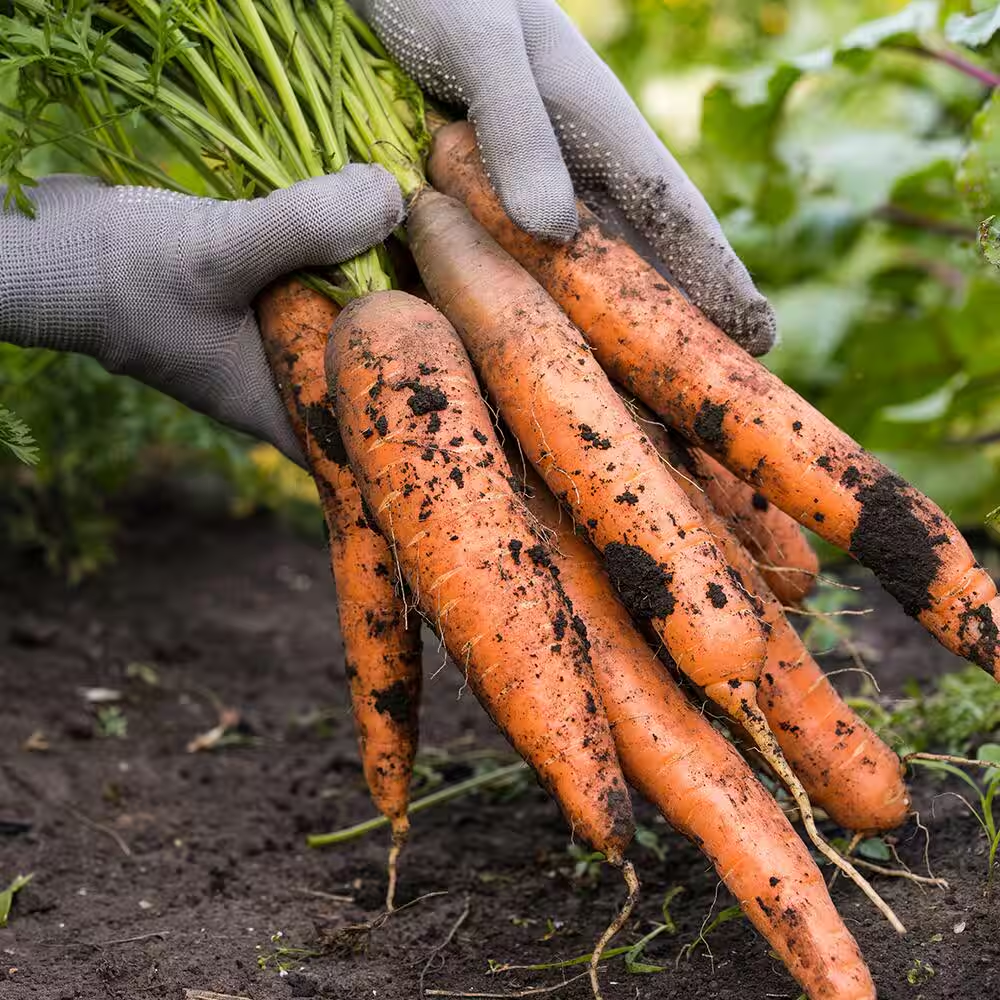Carrots are one of the most satisfying vegetables to grow — crisp, colorful, and full of homegrown sweetness. But if you’ve ever pulled up a carrot only to find it looking more like a cluster of twisted fingers than a sleek, straight root, you’re not alone.
Forked or deformed carrots are one of the most common problems gardeners face. They may still taste great, but their shape can make them difficult to clean, peel, or store — and let’s face it, everyone dreams of harvesting those long, perfect carrots you see in seed catalog photos.
The good news? Forking is entirely preventable. With the right soil preparation, watering habits, and care techniques, you can grow straight, smooth, and perfectly formed carrots every time.
Here’s a complete guide on why carrots fork — and the simple steps you can take to stop it from happening in your garden.
Why Do Carrots Fork?

Forked carrots occur when the main taproot (the part that grows down into the soil) is blocked, damaged, or diverted during its early growth stage. Instead of continuing straight down, the root splits or branches out in different directions.
Here are the most common causes:
- Compacted or rocky soil
Hard, clumpy, or heavy soils make it difficult for roots to grow straight. When the root tip hits an obstacle — like a rock or lump of clay — it splits into multiple directions. - Too much nitrogen
Over-fertilized soil, especially with fresh manure or high-nitrogen fertilizers, encourages excessive leafy growth and causes distorted roots. - Transplanting seedlings
Carrots hate having their roots disturbed. If you start them indoors or try to transplant, even slight root damage can cause forking. - Inconsistent watering
Irregular watering leads to uneven soil moisture, which can cause stress and deformities in developing roots. - Pest or disease interference
Nematodes, wireworms, or root maggots can damage root tips, causing them to fork as they heal and continue growing.
Step 1: Start With the Right Soil
Perfect carrots start underground — literally. If the soil isn’t right, even the best care won’t save you from forking.
Choose Loose, Deep, and Well-Draining Soil
Carrots need to push straight down, so aim for soil that’s soft and crumbly to at least 12 inches deep.
- Best soil type: Sandy loam or light, fine-textured soil.
- Avoid: Heavy clay, rocky ground, or soil that clumps when squeezed.
If your garden soil is compacted, consider growing carrots in raised beds or deep containers at least 10–12 inches tall. This gives you complete control over the texture and drainage.
How To Prepare the Soil:
- Loosen soil deeply with a garden fork — don’t just till the top few inches.
- Remove all rocks, sticks, and clods of soil.
- Mix in finished compost or sifted leaf mold, but avoid manure (even composted) right before planting.
- Rake the surface smooth before sowing seeds.
Pro Tip: If your soil is heavy, try shorter, stump-rooted carrot varieties like ‘Paris Market’ or ‘Thumbelina’ — they perform beautifully even in less-than-ideal soil.
Step 2: Avoid Over-Fertilizing
Too much fertilizer, especially nitrogen-rich ones, can cause excessive top growth and distorted roots. Carrots prefer nutrient-balanced but low-fertility soil.
Fertilizing Guidelines:
- Before planting, mix in a balanced organic fertilizer (like 5-10-10) at half the recommended rate.
- Avoid fresh manure or unaged compost — they’re notorious for causing forking.
- During growth, skip nitrogen-heavy feeds. If needed, side-dress with compost tea or kelp meal to promote steady, gentle growth.
Tip: If your soil is rich from previous plantings or compost additions, you may not need any fertilizer at all. Carrots are light feeders!
Step 3: Plant Seeds Directly in the Garden

Unlike tomatoes or peppers, carrots don’t transplant well. Even minor root disturbance can lead to crooked or forked carrots.
How to Plant Carrot Seeds Correctly:
- Sow seeds directly into the prepared soil about ¼ inch deep.
- Space seeds about 1 inch apart in rows 12–18 inches apart.
- Keep soil moist but not soggy until seedlings emerge (usually 10–20 days).
- Thin seedlings to 2 inches apart once they’re a few inches tall — crowded roots twist and fork as they compete for space.
If you’re planting in containers, choose a mix of half garden soil, half coarse sand or perlite for ideal drainage.
Step 4: Maintain Consistent Moisture
Uneven watering is another key reason for misshapen carrots. When soil alternates between dry and wet, roots expand irregularly — creating cracks, splits, or multiple tips.
Best Watering Practices:
- Keep the soil consistently damp (like a wrung-out sponge).
- Water deeply once or twice a week rather than shallow daily sprinkles.
- Mulch with straw or shredded leaves to retain moisture and prevent soil crusting.
Tip: Use drip irrigation or soaker hoses to deliver even moisture directly to the root zone — carrots love it!
Step 5: Control Pests and Diseases
Even the smallest pest damage to a root tip can cause forking as the carrot tries to regrow around the injury.
Common Culprits:
- Root-knot nematodes: Microscopic worms that cause small swellings and distorted roots.
- Wireworms: Yellow-brown larvae that chew through roots.
- Carrot root fly: Larvae that tunnel into carrots, leaving scars and forking points.
Natural Solutions:
- Rotate crops yearly — never plant carrots in the same spot two years in a row.
- Add beneficial nematodes to the soil to target root pests naturally.
- Cover seedlings with fine mesh row covers to prevent carrot fly.
- Solarize the soil (cover with clear plastic for 4–6 weeks) before planting to kill soil-borne pests.
Healthy, pest-free roots grow straight and strong.
Step 6: Thin Seedlings Properly

Crowded carrots twist and fork as they compete underground. Thinning may seem wasteful, but it’s essential.
How to Thin Without Damaging Roots:
- Wait until seedlings are about 2 inches tall.
- Gently snip extra seedlings at soil level with scissors (don’t pull them out).
- Leave about 2 inches of space between each plant.
Thinning helps each carrot grow freely without hitting a neighbor’s roots — one of the top causes of forking.
Step 7: Choose the Right Varieties

Some carrot varieties are naturally better suited for specific soil types.
For Heavy or Rocky Soil:
- Paris Market
- Thumbelina
- Short ‘n Sweet
For Loose, Deep Soil:
- Nantes
- Danvers 126
- Imperator 58
Choose the variety that matches your growing conditions — not all carrots are meant to grow foot-long and slender!
Step 8: Harvest Carefully
Even perfect carrots can fork or break if harvested carelessly.
How to Harvest Right:
- Water the soil lightly before pulling — this loosens it.
- Gently wiggle carrots side to side while pulling upward.
- For larger or deep-rooted varieties, use a garden fork to lift from underneath.
Avoid yanking or twisting — that’s how roots snap or bend.
Bonus Tips for Straight, Smooth Carrots
- Sift your topsoil. Removing even small pebbles can make a big difference.
- Test pH: Carrots prefer slightly acidic to neutral soil (6.0–6.8).
- Keep the surface loose: Crusted soil can deflect tender young roots sideways.
- Rotate crops: Avoid planting after root vegetables or legumes to reduce pest pressure.
- Don’t rush the process: Carrots grow best slowly in cool weather — rushing them with excess fertilizer or heat causes deformities.
Common Mistakes to Avoid

- Using fresh manure or unfinished compost.
- Planting too shallow — roots need depth to grow straight.
- Ignoring thinning — overcrowded carrots always deform.
- Overwatering right after germination — soggy soil suffocates root tips.
- Forgetting to loosen soil between plantings — compact layers remain from last season.
Avoiding these few pitfalls can make the difference between stubby, twisted carrots and beautiful, market-quality roots.
Final Thoughts
Growing perfect, fork-free carrots isn’t about luck — it’s about understanding what those roots need beneath the surface. Loose, rock-free soil, balanced nutrients, gentle watering, and minimal disturbance are the key ingredients.
When you take the time to prepare your soil and nurture your seedlings properly, your carrots will reward you with straight, crisp, and delicious roots — the kind that make pulling them from the soil pure joy.
So next time you plant carrots, give them space, softness, and steady care. You’ll soon be harvesting the kind of picture-perfect carrots that make you feel like a master gardener — because, with these steps, you’ll be one.






Leave A Comment